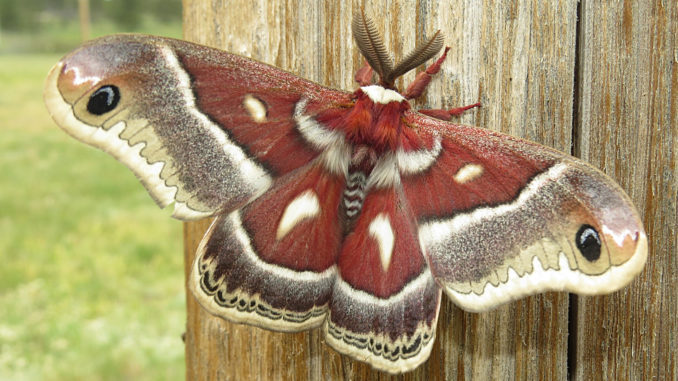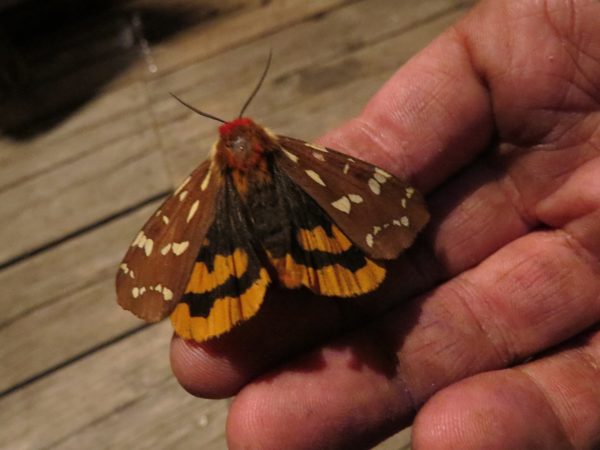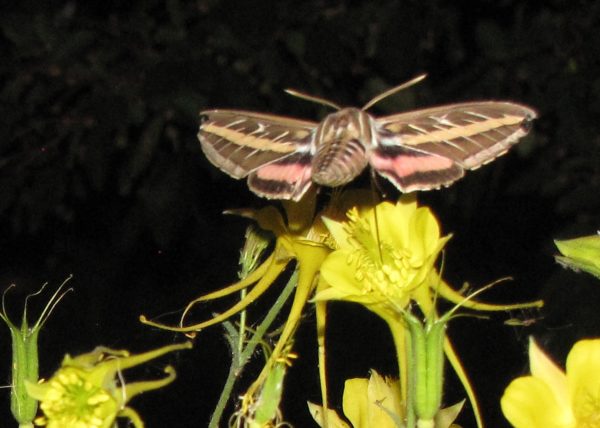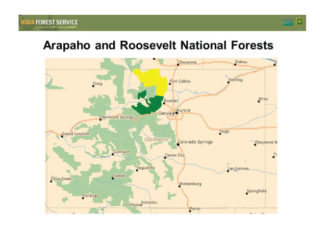
Matt Bartmann
[email protected]
Almost everything has its day. In January, we celebrated National Squirrel Appreciation Day. October brings us International Sloth Day. There’s a cat day, a pig day and, of course, a dog day.
Moths get a whole week! The last week of July, from July 21 through July 29 this year, is National Moth Week, when entomologists and casual “bug” enthusiasts alike celebrate moths and share their fascination with anyone who’s interested.
Gatherings both public and private are held—at night, of course!—to attract moths to a light, where they can be looked at and appreciated for their beauty and diversity. Experts and newbies ooh and ahh together over the creatures, and names are reeled off as the moths arrive. To look for a gathering near you, or to register your own moth appreciators get-together, see http://nationalmothweek.org/events-map-2/
With more than 100,000 species in the U.S. (no one actually knows how many), every night brings different kinds of moths to the light. The surprise is a big part of the fun.

The St. Lawrence tiger moth ranges from Alaska to Labrador—and often shows up at porch lights in the higher elevations of NOCO, including Red Feather Lakes, Livermore and the Roosevelt National Forest.
Moths are still a mystery, even to scientists. “We know collectively very little about moths, except for those species that have a negative economic impact,” says moth lover and field guide author Eric Eaton. He’s the chairman of the board of the Mile High Bug Club, which has been organizing National Moth Week events in Colorado for years.
What we do know is that moths pay a vital role in the ecosystem. “The overwhelming majority of moths feed birds, devour noxious weeds [via their caterpillars], pollinate wildflowers and otherwise keep the planet’s ecosystems functioning properly,” says Eaton.
It’s easy to get hooked on moth-watching—looking at the moths attracted to a light—because of their beauty and variety. Moths in Northern Colorado range in size from about a quarter inch for “micros,” to moths as big as your hand. Every species has different colors and markings, and all are remarkable.
Most moths are creatures of the night, because that’s when they’re naturally active. But there are day-flying moths, too, including the very convincingly disguised “hummingbird moths” that zip around to drink nectar from flowers in the garden both day and night.

Look for big white-lined sphinx moths at your flowers both day and night. Like hummingbirds, they hover while sipping nectar.
To learn more about moths and the week of appreciation, visit http://nationalmothweek.org. To get an idea of the incredible diversity of moths, or to post photos of your own finds and get them identified, visit the popular Facebook page “Mothing and Moth-Watching” at https://facebook.com/groups/137219092972521/
Bring in the moths
If you want to see moths up close, simply leave your porch light on all night. To make the moths easier to see and admire, hang a white cloth under the light: The moths will gather on your “moth sheet” to rest, and most will still be there in the early morning.
Today’s LED bulbs are less appealing to moths than incandescent bulbs, but they’ll still attract a variety of the night-flying insects. Moth aficionados often graduate to special bulbs and black lights to bring in even more.
Away from home, check the walls near bright lights at convenience stores, highway rest stops, gas stations or other night-lit businesses. They often draw in beautiful moths, especially large sphinx moths and gorgeous giant silk moths.
Moth-watching is rapidly growing in popularity. It’s fun for the whole family—and it’s free! All you need is a light bulb, and enough patience to look closely at the moths that the bulb draws in.
It’s miller time!
There’s no doubt that moths can also be annoying. They flutter around our nighttime reading lamp or swarm around our heads when we pass the porch light. Their caterpillars may eat our prized plants. And when they show up in mass quantity, as miller moths do, appreciation is hard to come by.
Millers are mostly “army cutworm” moths, and they’re just doing what comes naturally. Agricultural crops are a banquet for the caterpillars, which feast on them all spring, then pupate in the soil. In May and June, the newly hatched adult moths migrate westward, traveling 100 miles or more to the high plains of Wellington, Windsor, Fort Collins and other Front Range areas, as well as up into the mountains.
Millers spend the summer feeding on nectar and enjoying some R&R. Then, from late summer into fall, the moths reverse their migration, traveling back to the farm fields to mate and lay eggs. To learn more about the unusual habits of these pesky brown mid-sized moths, go to http://extension.colostate.edu/topic-areas/insects/miller-moths-5-597/
Support Northern Colorado Journalism
Show your support for North Forty News by helping us produce more content. It's a kind and simple gesture that will help us continue to bring more content to you.
BONUS - Donors get a link in their receipt to sign up for our once-per-week instant text messaging alert. Get your e-copy of North Forty News the moment it is released!
Click to Donate




The only thing I know about moths is that some of them eat holes in my clothes.